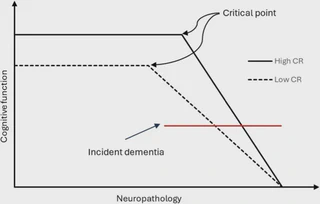The moderating effect of cognitive reserve on cognitive aging

The concept of reserve is categorized into two distinct processes: a passive model known as “Brain Reserve,” and an active model known as “Cognitive Reserve” (CR). Brain reserve refers to the structural capacity—essentially the hardware—that allows an individual to sustain a certain threshold of neuropathological damage before clinical symptoms emerge. In contrast, CR represents the brain’s functional resilience—the software—enabling dynamic adaptation and resource optimization to maintain performance despite pathology. In the context of Alzheimer’s Disease (AD), CR plays a complex, dual role. It initially serves as a protective buffer, mitigating the cognitive impact of early neuroimaging biomarkers and allowing individuals to function normally despite accumulating damage. However, this protection involves a trade-off: high CR is often associated with a sharper trajectory of decline in later disease stages once compensatory mechanisms are finally exhausted. Evidence suggests that the “critical point” for this transition likely lies in the interval between the Cognitively Unimpaired (CU) stage and Mild Cognitive Impairment (MCI) (Guo et al., 2025).